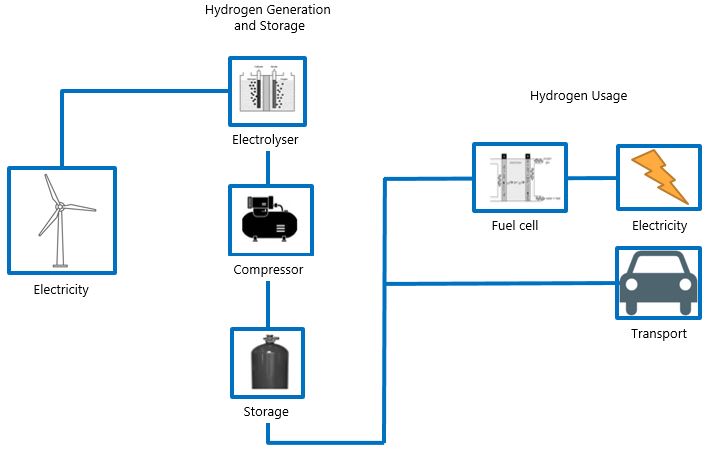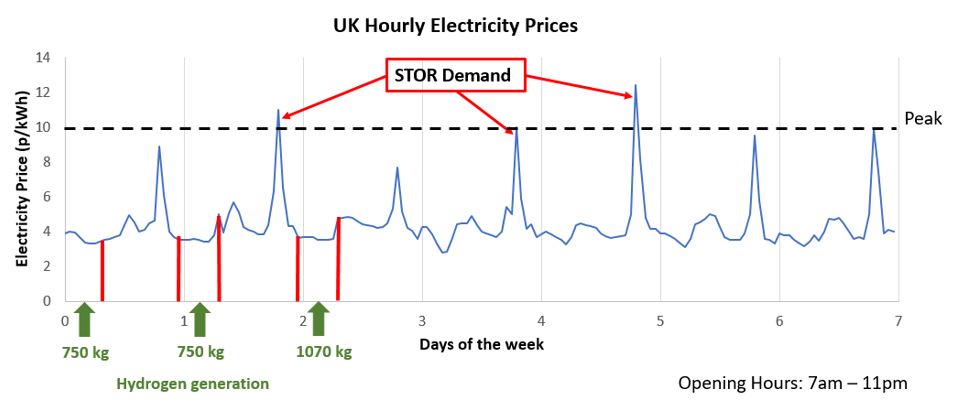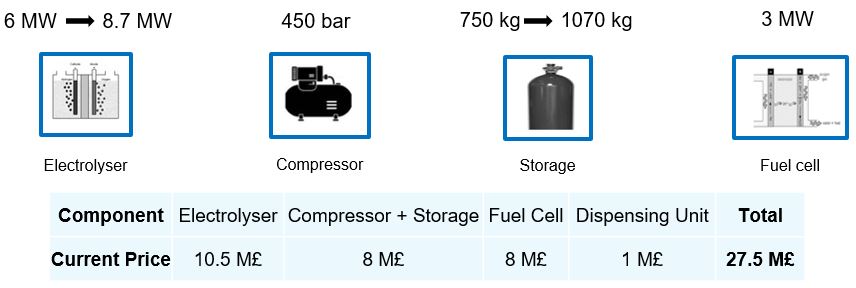The current UK national grid was designed to work with centralised power generation systems. However, recent years have proven that more clean energy generated from embedded renewable energy systems connected to the grid can cause major problems, including an imbalanced grid network: this has grown to be a large issue that needs to be addressed promptly.
The high levels of air pollution present in many cities - most of which is caused by fossil fuel vehicles - including UK cities, such as Glasgow, also imposes a demand for new technology. This is where the hydrogen economy can be utilised. Hydrogen can be used to replace fossil fuels, providing a favourable, practical solution to this global issue.
By combining STOR and Refuelling Station units together, as shown in Figure 1, the potential of the hydrogen technology can be fulfilled whilst tackling two parts of the well-known energy trilemma (power, transport and heat). Having one infrastructure with two applications means that the capital and operational costs are shared, thus making the system more profitable and financially feasible.
The high levels of air pollution present in many cities - most of which is caused by fossil fuel vehicles - including UK cities, such as Glasgow, also imposes a demand for new technology. This is where the hydrogen economy can be utilised. Hydrogen can be used to replace fossil fuels, providing a favourable, practical solution to this global issue.
By combining STOR and Refuelling Station units together, as shown in Figure 1, the potential of the hydrogen technology can be fulfilled whilst tackling two parts of the well-known energy trilemma (power, transport and heat). Having one infrastructure with two applications means that the capital and operational costs are shared, thus making the system more profitable and financially feasible.
Methodology
The mathematical model was modified to study the feasibility of a combined system, which was designed to meet both power and transportation demands. The model is based on the same assumptions as before, including: an identical Short Term Operation Reserve contract, providing 3 MW for 2 hours 3 times a week; and a capacity of 150 hydrogen fuel cell vehicles per day, which would refill each tank from empty to full (5 kg of hydrogen).
The input electricity prices to the model correspond to the current situation of 2017, and predicted lowered prices due to more renewable energy generation in the future. Regardless of the current or future predictions, the UK electricity prices are the lowest during night times, as the electricity demand is low. Therefore, the combined station will be closed between 11 pm and 7 am taking advantage of the cheap electricity rates to recharge the hydrogen storage tank every night. The parameter inputs correspond to the previous model, except the UK hourly electricity prices that were taken from the whole week in March 2017 (Sunday, March 5th till Saturday, March 11th). The mathematical model was, once again, designed to calculate annual profit and money available for the investment.
The input electricity prices to the model correspond to the current situation of 2017, and predicted lowered prices due to more renewable energy generation in the future. Regardless of the current or future predictions, the UK electricity prices are the lowest during night times, as the electricity demand is low. Therefore, the combined station will be closed between 11 pm and 7 am taking advantage of the cheap electricity rates to recharge the hydrogen storage tank every night. The parameter inputs correspond to the previous model, except the UK hourly electricity prices that were taken from the whole week in March 2017 (Sunday, March 5th till Saturday, March 11th). The mathematical model was, once again, designed to calculate annual profit and money available for the investment.
Results and Discussion
The example of our combined system is shown in the Figure 2. The figure is based on real data gathered in March 2017. The electrolyser is designed to electrolyse water to create hydrogen for 8 hours a day when the electricity prices are the lowest. 750 kg of hydrogen is required to satisfy a capacity of 150 cars a day. In addition, there will always be enough hydrogen stored in the tank in case we are called by the National Grid as a Short Term Operating Reserve to provide 3 MW for 2 hours when the power generation cannot meet the demand.
As seen in the Figure 2, no call has been received on Monday, and therefore only 750 kg of hydrogen was generated at night. On the other hand, the system was called on Tuesday at 6 pm to meet the STOR demand. Therefore, more electricity must be dragged from the grid during the following night to create 1,070 kg of hydrogen to refill the entire hydrogen storage tank. This procedure would be repeated for the rest of the week.
Even though the combined unit has many benefits, related drawbacks should also be discussed. Assuming the charging time of 8 hours, the power consumption during electrolysis increases. This means that the required electrolyser size has to be increased accordingly. The compressor needs to meet the same pressure of 450 bar, however storage size will increase to store enough hydrogen for both applications. Fuel cell size will remain the same, as the STOR contract has not been changed either. These adjusted technical parameters would only slightly increase the capital cost of the system, while making a large contribution to the profit of the entire system.
The capital cost of each component is shown in the Figure 3. The estimated values have been collected at the Aberdeen Hydrogen Transport Summit that provided us with a relevant financial analysis research paper. Due to the size of our system, these prices are approximate and are very likely to change in the future. Nevertheless, the current capital cost required to build the combined system has been estimated at £27.5m. [2]
The annual profit of the combined unit was calculated as £119k with current electricity prices, and there would be £24.3m capital loan for the investment. This means that our system is not viable to build in 2017. Even though the current capital cost of the system is not significantly higher than the calculated capital loan value, there would not be a hydrogen fuel demand of 150 cars a day at the moment. On the other hand, the system could be more financially profitable and receive higher capital loan (Figure 4) if it is built in the future with more hydrogen fuel cell vehicles on the road, more renewable generation sources on the market and therefore more time with very cheap or negative electricity prices.
The annual profit of the combined unit was calculated as £119k with current electricity prices, and there would be £24.3m capital loan for the investment. This means that our system is not viable to build in 2017. Even though the current capital cost of the system is not significantly higher than the calculated capital loan value, there would not be a hydrogen fuel demand of 150 cars a day at the moment. On the other hand, the system could be more financially profitable and receive higher capital loan (Figure 4) if it is built in the future with more hydrogen fuel cell vehicles on the road, more renewable generation sources on the market and therefore more time with very cheap or negative electricity prices.
| Combined System.xlsx | |
| File Size: | 115 kb |
| File Type: | xlsx |
[1] http://nordpoolspot.com/Market-data1/N2EX/Auction-prices/UK/Hourly/?view=table
[2] New Bus ReFuelling for European Hydrogen Bus Depots. Guidance Document on Large Scale Hydrogen Bus Refuelling. European Commission, March 2017.
[2] New Bus ReFuelling for European Hydrogen Bus Depots. Guidance Document on Large Scale Hydrogen Bus Refuelling. European Commission, March 2017.





